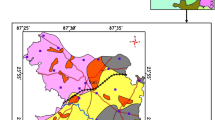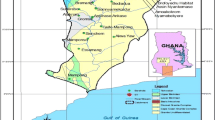Abstract
The majority of communities in the Central Region rely heavily on groundwater as their primary water source because anthropogenic activities like mining and agriculture have a negative impact on the accessible surface water bodies. This necessitates a detailed comprehension of the mechanisms that influence the groundwater quality for drinking, domestic, and other uses in the region. Within the Assin North and South Municipalities, multivariate statistical approaches have been used to evaluate the chemistry of groundwater, identify the geologic variables influencing the groundwater chemistry, and identify potential anthropogenic sources of groundwater pollution. The groundwater types in the region are CaMgHCO3, Mixed, NaCl, and CaMgSO4. While the factor analysis technique identified five variables that explained a total variance of 77.541%, the cluster analysis technique identified three clusters. Factor 1 contributed 28.25%, Factor 2 made up 20.791%, Factor 3 made up 16.583%, Factor 4 made up 6.404%, and Factor 5 made up 5.514%. The relationship between the variables and the strength of the associations was shown by the correlation approach. The study has shown that anthropogenic activities like improper pesticide application, galamsey, and improper waste disposal affect the chemistry of the groundwater in addition to natural processes like rock weathering, mixing processes, and ion exchange. The application of the multivariate statistical techniques in the examination of the hydrochemical mechanisms that regulate the chemistry and general quality of groundwater has proven the effectiveness of the techniques. The results of the study have demonstrated the value of multivariate statistical analysis in hydrochemical research.






Similar content being viewed by others
Data availability
All data used for this study are included within the manuscript.
References
Acero, P., Gutiérrez, F., Galve, J. P., Auqué, L. F., Carbonel, D., Gimeno, M. J., et al. (2013). Hydrogeochemical characterization of an evaporite karst area affected by sinkholes (EbroValley, NE Spain). Geologica Acta, 11(4), 389–407.
America Public Health Association. (1995). Standard methods for the examination of water and waste water, 19th edition, Washington, DC.
Alberto, W. O., Del, P. D. M., Valeria, A. M., Fablana, P. S., Cecilia, H. A., & De Los Angeles, B. M. (2001). Patternrecognition techniques for the evaluation of spatial and temporal variations in water quality. A case study: SuquiaRiver Basin (Cordoba-Argentina). Water Research, 35, 2881–2894.
Appelo, C. A. J, & Postma, D. (2005). Geochemistry, groundwater and pollution, 2nd edition.
Argamasilla, M., Barberà, J. A., & Andreo, B. (2017). Factors controlling groundwater salinization and hydrogeochemical processes in coastal aquifers from southern Spain. Science of the Total Environment, 580, 50–68.
Arnould, M. (1961). Étude Géologique des Migmatites et des Granites Précambriens du Nord-est de la Côre d’Ivoireet de la Haute-Volta Méridionale: Cadre Géologi-que, Classification. Editions Technip, Paris: Principaux Types.
Asante-Annor, A., Acquah, J., & Ansah, E. (2018). Hydro-geological and hydrochemical assessment of basin Granitoids in Assin and Breman Districts of Ghana. Journal of Geoscience and Environment Protection, 6.
Ayenew, T., Fikre, S., Wisotzky, F., Demlie, M., & Wohnlich, S. (2009). Hierarchical cluster analysis ofhydrochemical data as a tool for assessing the evolution and dynamics of groundwater across the Ethiopian rift. International Journal of Physical Sciences, Vol. 4 (2), 076–090.
Belkhiri, L., Abderrahmane, B., & Mouni, L. (2010). A multivariate statistical analysis of groundwater chemistry data. International Journal of Environmental Research, 5(2), 537–544.
Black, R., & White, H. (2004). Targeting development. Routledge.
Celesceri, L., Greenberg, A. E., & Eaten, A. D. (1998). Standard methods for the examination of water and waste water. American Public Health Association.
Chapelle, F. H., & Knobel, L. L. (1983). Aqueous geochemistry and the exchangeable cation composition of glauconite in the Aquia aquifer, Maryland. Groundwater, 3, 343.
Choubisa, S. L. (2001). Endemic fluorosis in Southern Rajasthan, India. Fluoride, 34.
Darko H. F., Karikari A. Y., Duah A. A., Akurugu B. A., Mante V., & Teye F. O. (2021). Effect of small-scale illegal mining on surface water and sediment quality in Ghana. International Journal of River Basin Management, 1–26.
Driscoll, C. T., Likens, G. E., Hedin, L. O., Eaton, J. S., & Bormann, E. H. (1989). Changes in the chemistry of surface waters: 25-years results at the Hubbard Brook Experimental Forest. Environmental Science and Technology, 23, 137.
Davis, J. (2002). Statistical and data analysis in geology. New York: John Wiley and Sons.
European Environment Agency. (1999). Groundwater quality and quantity in Europe: Data and basic information. Technical report, Copenhagen.
Ewusi, A., & Seidu, J. (2018). Hydrogeology of the Basin Granitoids in the Sekyere South District of Ashanti Region, Ghana. Journal of Geoscience and Environment Protection, 6, 252–263.
Freeze, R. A., & Cherry, J. A. (1979). Groundwater. Prentice-Hall, Inc.
Ganyaglo, S. Y., Banoeng-Yakubo, K. B., Osae, S., Dampare, S. B., Fianko, J. R., & Bhuiyan, M. A. H. (2010). Hydrochemical and Isotopic Characterisation of Ground-water in Eastern Region of Ghana. Journal of Water Resource and Protection, 2, 199–208.
Ganyaglo, S. Y., Osae, S., Dampare, S. B., Fianko, J. R., Bhuiyan, M. A. H., Gibrilla, A., et al. (2012). Preliminarygroundwater quality assessment in the central region of Ghana. Environ. Earth Sci, 66, 573 –587. https://doi.org/10.1007/s12665-011-1266-7.
Ganyaglo, S. Y., Osae, S., Akiti, T., Armah, T., Gourcy, L., Vitvar, T., & Otoo, I. A. (2017). Application of geochemical and stable isotopic tracers to investigate groundwater salinity in the Ochi-Narkwa basin, Ghana. Hydrological Sciences Journal, 62(8), 1301–1316.
Ghana Statistical Services. (2000). Population and housing census.
Ghosh, A. (2007). Current knowledge on the distribution of arsenic in groundwater in five states of India. Journal of Environmental Science and Health, Part A, 42.
Gibbs, R. J. (1970). Mechanisms controlling world water chemistry. Science Journal, 170, 795–840.
Hem J. D. (1985). Study and interpretation of the chemical characteristics of natural water, 3rd edition. U.S. Geological Survey Water-Supply Paper 2254.
Helstrup, Tina, Oluf Jørgensen, N. O., & Banoeng-Yakubo, B. (2007). Investigation of hydrochemicalcharacteristics of groundwater from the Cretaceous-Eocene limestone aquifer in southern Ghana and SouthernTogo using hierarchical cluster analysis. Hydrogeology Journal, 15, 977–989.
Hirdes, W., Davis, D. W., & Eisenlohr, B. N. (1992). Reassessment of proterozoic granitoid ages in Ghana on the basis of U/Pb zircon and monazite dating. Pre-Cambrian Research, 56, 89–96.
Junner, N. R. (1940). Geology of the Gold Coast and Western Togoland (with re-vised geological map). Gold Coast Geological Survey Bulletin No. 11.
Kaiser, H. F. (1960). The application of electronic computers to factor analysis. Educational and Psychological Measurement, 20, 141–151.
Karanth, K. R. (1989). Groundwater assessment, development and management. New Delhi: Tata McGraw-Hill.
Koh, D. C., Mayer, B., Lee, K. S., & Ko, K. S. (2010). Land-use controls on sources and fate of nitrate in shallow groundwater of an agricultural area revealed by multiple environmental tracers. Journal of Contamination Hydrology, 118, 62–78.
Kuells, C., Adar, E. M., & Udluft, P. (2000). Resolving patterns of groundwater flow by inverse hydrochemicalmodelling in a semiarid Kalahari basin.
Langelier, W. F., & Ludwig H. F. (1942). Graphical methods for indicating the mineral character of natural waters.
Lapworth, D. J., Nkhuwa, D. C. W., Okotto-Okotto, J., Pedley, S., Stuart, M. E., Tijani, M. N., & Wright, J. (2017). Urban groundwater quality in sub-Saharan Africa: Current status and implications for water security and public health. Hydrogeology Journal, 25, 1093–1116.
McMahon, P. B., Belitz, K., Reddy, J. E., & Johnson, T. D. (2019). Elevated manganese concentrations in United States groundwater, role of land surface-soil-aquifer connections. Environmental Science and Technology, 53, 29–38.
Morris, B. L., Lawrence, A. R. L., Chilton, P. J. C., Adams, B., Calow, R. C., & Klinck, B. A. (2003). Groundwater and its susceptibility to degradation. A global assessment of the problem and options for management. Early Warning and Assessment Report Series, R S 03-3. United Nations Environmental Progamme, Nairobi, Kenya.
Mohan, R., Singh, A. K., Tripathi, J. K., & Chowdhary, G. C. (2000). Hydrochemistry and quality assessment ofgroundwater in Naini industrial area, Allahabad District, Uttar Pradesh. Journal of the Geological Society of India, 55, 77–89.
Oluduro, A. O., & Adewoye, B. I. (2007). Efficiency of moringa Oleifera Sead extract on the microflora of surface and ground water. Journal of Plant Sciences, 6, 453–438.
Osiakwan, G. M., Appiah-Adjei, E. K., Kabo-Bah, A. T., Gibrilla, A., & Anornu, G. (2021). Assessment of groundwater quality and the controlling factors in coastal aquifers of Ghana: An integrated statistical, geostatistical and hydrogeochemical approach. Journal of African Earth Sciences., 184, 104371.
Otto, M. (1998). Multivariate methods. In R. Kellner, J. M. Mermet, M. Otto, & H. M. Widmer (Eds.), Analytical chemistry. Weinheim: WileyeVCH.
Piper, A. M. (1944). A graphic procedure in the geochemical interpretation of water analyses. Transactions, American Geophysical Union, 25, 914–928.
Schoeller, H. (1965). Qualitative evaluation of groundwater resources. In H. Schoeller (Ed.), Methods and techniques of groundwater investigations and development (pp. 54–83). Paris: The United Nations Educational, Scientific and Cultural Organization.
Stiff, H. A. (1951). The interpretation of chemical water analysis by means of patterns. Journal of Petroleum Technology, 3(10).
Swan, A. R. H., & Sandilands, M. (1995). Introduction to geological data analysis. Oxford: Blackwell.
Tiwari, A. K., & Singh, A. K. (2014). Hydrogeochemical investigation and Groundwater Quality Assessment of Pratapgarh District, Uttar Pradesh. Journal of the Geological Society of India, 83(3), 329–343p.
United Nations Environmental Program (UNEP). (1999). Global environmental outlook 2002, UK: Earth scan.
United States Environmental Protection Agency. (1998). Land farming. Office of the Underground Storage Tank, US Environmental Protection Agency. 510-B-95.
United States Salinity Labortory. (1954). Diagnosis and improvements of saline and alkali soils. US Department of Agricultural Soils, US Department of Agricultural Hand Book 60, Washington.
Walton, W. C. (1970). Ground water resources evolution. McGraw Hill.
Werner, A. D., Bakker, M., Post, V. E. A., Vandenbohede, A., Lu, C., Ataie-Ashtiani, B., & Barry, D. A. (2013). Seawater intrusion processes, investigation and management: Recent advances and future challenges. Advances in Water Resources, 51, 3–26.
Wilcox, L.V. (1955). Classification and use of irrigation waters. U.S. Department of Agriculture Circular 969. Washington, DC: U.S. Dept. Agric.
World Health Organization. (1996). Guidelines for drinking-water quality, 2nd edition. WHO Library Cataloguing in Publication Data Contents: v.2. Health criteria and other supporting information 1. Drinking water—standards ISBN 92 4 154480 5 (v. 2) (NLM Classification: WA 675).
World Health Organization. (2006). Guidelines for drinking-water quality first addendum to third edition volume 1 incorporating first addendum. 92 4 154696 4.
World Health Organization. (2008). Guidelines for drinking-water quality: incorporating 1st and 2nd addenda, vol. 1, Recommendations 978 92 4 1547611.
World Health Organization. (2012). Edition of the drinking water standards and health advisories Environmental Protection Agency 822-S-12-001 Washington, DC.
Zhai, Y., Han, Y., Xia, X., Li, X., Lu, H., Teng, Y., & Wang, J. (2021). Anthropogenic organic pollutants in groundwater increase releases of Fe and Mn from aquifer sediments: Impacts of pollution degree, mineral content, and pH. Water, 13, 1920.
Acknowledgements
The author is appreciative to the Management of the CWSA, Cape Coast for making data for this study available.
Funding
The author received no funding for this study.
Author information
Authors and Affiliations
Corresponding author
Ethics declarations
Conflict of interest
The author declares that he has no conflict of interest.
Rights and permissions
Springer Nature or its licensor (e.g. a society or other partner) holds exclusive rights to this article under a publishing agreement with the author(s) or other rightsholder(s); author self-archiving of the accepted manuscript version of this article is solely governed by the terms of such publishing agreement and applicable law.
About this article
Cite this article
Agyemang, V.O. Integration of statistical techniques in groundwater pollution investigation in the Assin north and south municipalities, Ghana. Int J Energ Water Res 7, 567–580 (2023). https://doi.org/10.1007/s42108-022-00232-x
Received:
Accepted:
Published:
Issue Date:
DOI: https://doi.org/10.1007/s42108-022-00232-x




